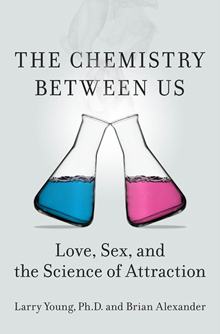
Emory neuroscientist Larry Young helps explain in his new book the brain chemistry behind many human behaviors that govern our lives.
In "The Chemistry Between Us: Love, Sex and the Science of Attraction," now available nationwide, neuroscientist Larry Young and journalist Brian Alexander draw on human stories and cutting-edge research from around the world to flesh out the behaviors that govern our lives, such as physical attraction, infidelity and mother-infant bonding, and explain how our brains exert control over some of the most important and tumultuous decisions and events of our lives.
Young is chief of the division of behavioral neuroscience at Yerkes National Primate Research Center, the director of the Center for Translational Social Neuroscience (CTSN) at Emory University and the William P. Timmie Professor of Psychiatry at Emory's School of Medicine.
Co-author Alexander is the author of several books, including "Rapture: How Biotech Became the New Religion" (Basic Books) and "America Unzipped: The Search for Sex and Satisfaction" (Crown/Harmony). He has been a finalist for the National Magazine Award and recognized by Medill School of Journalism's John Bartlow Martin awards for public interest journalism and the Association of Healthcare Journalists.
Their book expands on Young's well-known research on the social neuroscience of bonding, most famously in voles, that what we call love is really the result of neurochemicals acting on defined brain circuits. They move from that simple premise to profound concepts about gender, sexuality, monogamy, infidelity, lust, parenting and the social and cultural implications of them all.
The authors explain the fascinating science behind questions such as:
- Why is there a female and a male brain – and what does that mean for our understanding of gender and sexuality?
- What's the difference in brain chemistry between a woman with a new baby and one with a new boyfriend? (hint: not much)
- Why do we cheat on our spouses, and are some of us genetically more likely to cheat?
Among those giving advance praise for the book is Frans de Waal, director of the Living Links Center at Yerkes and New York Times best selling author, who says, “This lively book by a great neuroscientist and a savvy writer is the first popular account to tie together what we have learned about the chemistry of sex, love and family bonds. Progress in this field has been nothing short of breathtaking, and Larry Young is recognized as its leading pioneer. The way our brains react when boy meets girl determines the stability of marriage and the future of the human family.”
Via Young's Yerkes and CTSN research programs, he focuses on understanding the genetic and neurobiological mechanisms underlying complex social behaviors, including social bonding and social attachments. This work has important implications for psychiatric disorders characterized by disruption in social cognition, including autism spectrum disorder and schizophrenia. Young and his colleagues not only want to better understand the social brain, they want to develop new treatment strategies for improving social functioning.
"The Chemistry Between Us" is published by Current, an imprint of the Penguin Group.
For more information, visit www.thechemistrybetweenus.com.
